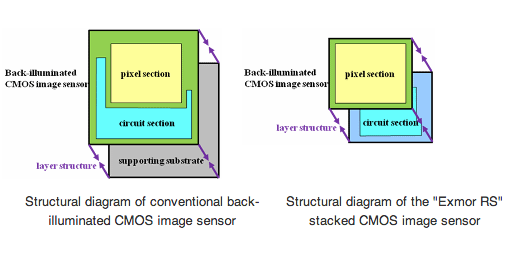OPPO Find 5 Review
by Vivek Gowri on May 29, 2013 6:55 AM EST- Posted in
- Smartphones
- Qualcomm
- Mobile
- APQ8064
- OPPO Find 5
The Find 5 was noted to be using Sony’s Exmor RS branded 13MP camera sensor pretty early on, with OPPO releasing preview images taken on a preproduction device way back in December of last year. This sensor, the Sony IMX135, is the next generation version of the IMX091PQ sensor found in devices like the Optimus G and the Galaxy S4, and can also be seen in Sony’s own Xperia Z. The two sensors basically cover the who’s who of current flagship smartphones between them, other than the HTC One. IMX135 is a 1/3.06” stacked CMOS with 13.13 effective megapixels and on-sensor HDR. The stacked structure part means that the pixel and circuit sections of the sensor are layered, as seen in the Sony-provided diagram below.

This layering replaces the supporting substrates used in conventional backside-illuminated CMOS sensors, allowing for a much more compact overall image sensor size. It’s definitely an interesting piece of tech, though the use of this sensor definitely points to an emphasis on megapixel count. As Brian has covered many times in the past, sensors with more densely packed pixels have less light sensitivity and dynamic range than sensors with larger pixels, so the presence of on-sensor HDR capability for both stills and video is definitely an important one given the 1.12um pixels in IMX135. The front facing camera uses the Samsung S5K6A3 sensor, which can also be found in the Galaxy S3 and Galaxy Note 2.
Optically, the Find 5 also has an F/2.2 lens and a focal length of 3.85mm. It shares a lot of the imaging characteristics of the Galaxy S4, which makes sense given the hardware-level similarities. The image processing is different, but it’s still a sensor with a very high spatial resolution that does a great job in well lit situations and seems to suffer when light sensitivity or dynamic range is important.
I took the Find 5 with me on a spring break trip to Hawaii and used it as my primary camera. It was pretty solid, but low light is a problem, particularly when objects are far enough away to not be impacted by flash. It’s impressive, when you look casually at the pictures coming out of modern smartphones in the right situations, to consider how far we’ve come in the last few years.
Compared to the HTC One, the OPPO is pretty competitive in bright outdoor shots, and definitely better when looked at 1:1. The low light story is a bit different - the One is just a lot better, and the lack of a night mode on the OPPO hamstrings it even further. Even shooting with HDR, the OPPO isn’t close. The dual LED flash is okay indoors and particularly with nearby subjects (within 5 feet) it does quite well, but relying on it outdoors in the dark will result in a near-useless picture.
Taken at night with the OPPO Find 5, Normal shooting mode with flash.
The lack of advanced camera settings really doesn’t help here. The camera interface is pretty simple, with a brushed metal feel and clearly laid out controls, but you don’t get access to critical functions like shutter speed, white balance, ISO, etc. The exposed settings are resolution, self-timer, face detection, geotagging, and a grid overlay for the UI. Other than that, you get the three shooting modes (normal, HDR, and panorama), as well as a flash control and toggles for front/rear camera and photo/video recording. It’s pretty light on settings, though for the purposes of most smartphone camera users it’s adequate. From a camera control perspective, this is not much better than Apple in terms of how little of it you actually get. The other disappointing thing about the camera interface is that the preview image runs at roughly 20 fps, which is a noticeable but mild annoyance while taking stills.




















39 Comments
View All Comments
VivekGowri - Friday, May 31, 2013 - link
Yeah okay, that was supposed to be polycarbonate, my apologies. It got missed among the other eight thousand words, Klug read over it twice before it posted too so we had enough internal editing, this just slipped through.Sertis - Thursday, May 30, 2013 - link
The button layout isn't too bad, having the power on the left side makes it less likely you'll turn off the device if you suddenly grip it tightly (if you're right handed, you'll apply much more pressure with your thumb than the other 4 fingers on the opposite side). Still, i'd rather have the button on the top. My (more agile) thumb can more easily pick and choose closely spaced buttons than my fingers so having buttons that won't "punish be by turning off the device if I hit the wrong one" on the right side is okay with me.Death666Angel - Thursday, May 30, 2013 - link
Wow, that's a lot of annoying software bugs. The cheap Chinese phone my wife has looks pretty good compared to that. Granted, it has and old dual core A9 SoC and only 720p (basically an SGS3 rip off), but it cost 165€. The Oppo Find 5 is currently listed for 466€ here (1 listing only). Not a good deal. If I don't want to deal with importing a cell phone (which one has to do to get the good deals on the Chinese stuff), I'd rather take an SGS3 for 330€ or spend up on the SGS4 for 550€ (HTC One is listed at 590€).Death666Angel - Friday, May 31, 2013 - link
Quote: "This is obviously less of a factor in Europe and Asia, where the prices are more equivalent"I can get the Nexus 4 for 299/349€ in the play store (+9€ shipping) here in Germany. That's about as pricey as the US variant, is it not (including the VAT thing)? :)
BeauCharles - Thursday, May 30, 2013 - link
Wow, strange that Oppo would get into this market. I own an Oppo DVD player and still use it regularly in this Blu-Ray era. Shame the phone doesn't live up the same level of performance (right now anyway) its DVD/Blu-Ray players do. Oppo is very good about firmware support with those and customer service in general - hopefully that'll be the case with the phonesmars2k - Friday, May 31, 2013 - link
Oppo may be unheard of in the phone sector but they have unheard of status in the home theater segment. They have completely re-written the book first with DVD playback and then with a series of giant killer BlueRay players. One player after another they have blown the competition out of the water in price/performance. They now make a universal player, BDP-105 whose performance cannot be beat without going into the stratosphere on cost. So much so that spending more is essentially pointless.If they pursue the phone market the way they went after DVD and BlueRay playback we will all soon be using Oppo phones.
Death666Angel - Friday, May 31, 2013 - link
The Oppo BDP-105 is going for 1340€ here in Germany. Isn't that stratosphere cost already? :P Seems like it integrates A/V receiver stuff as well. I don't like that. More hassle to upgrade. Oh well.tom5 - Saturday, June 8, 2013 - link
They recently started shipping this in Europe, unfortunately it doesnt support UMTS 900 MHz band that is widely used in Europe.But the biggest show stopper for me is the battery life - today this is the biggest problem in phones so the manufacturers must do everything to make battery life longer. This is where you experience matters, Oppo don't have this experience so we see the results: a phone that won't last you a day.
aranyak - Wednesday, December 2, 2015 - link
Oppo Find 5 is definitely one of the greatest creations of the company, however, Oppo recently made a announcement about Oppo Find 9 which i heard in http://www.techvicity.com/ .. well the phone is believed to be the flagship phone of the company in 2016 with 3 GB of RAM and 64 GB internal storage, that is something else man, really can't wait for it